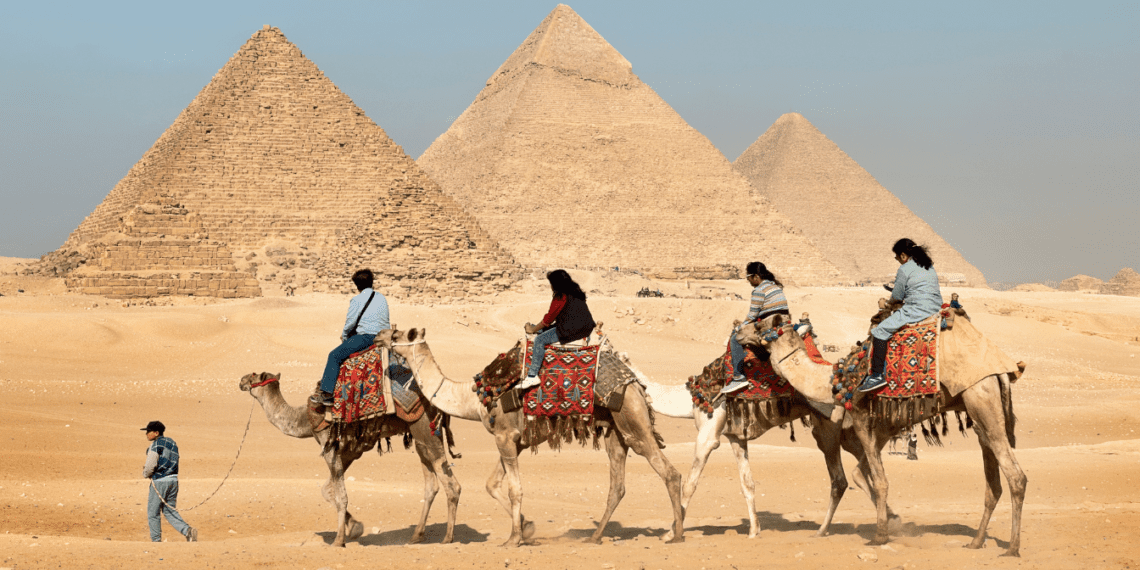Imagine stepping back in time and exploring Egypt’s captivating history. The country’s incredible architecture makes it one of the most fascinating places on earth. From the legendary Pyramids of Giza to the stunning Luxor temples, there’s much to see. Join us on a journey to uncover Egypt’s ancient secrets.
Key Takeaways
- Discover Egypt’s rich history and awe-inspiring ancient architecture
- Explore the iconic Pyramids of Giza and the captivating Luxor temples
- Immerse yourself in the captivating history of the Valley of the Kings
- Marvel at the grandeur of the Egyptian Museum in Cairo
- Embark on a Nile River cruise and witness essential historical sites
But what secrets do these ancient monuments hold? What hidden wonders await the curious traveler? Let’s uncover the mysteries of Egypt’s past. Discover why it stands as a captivating destination to the world.
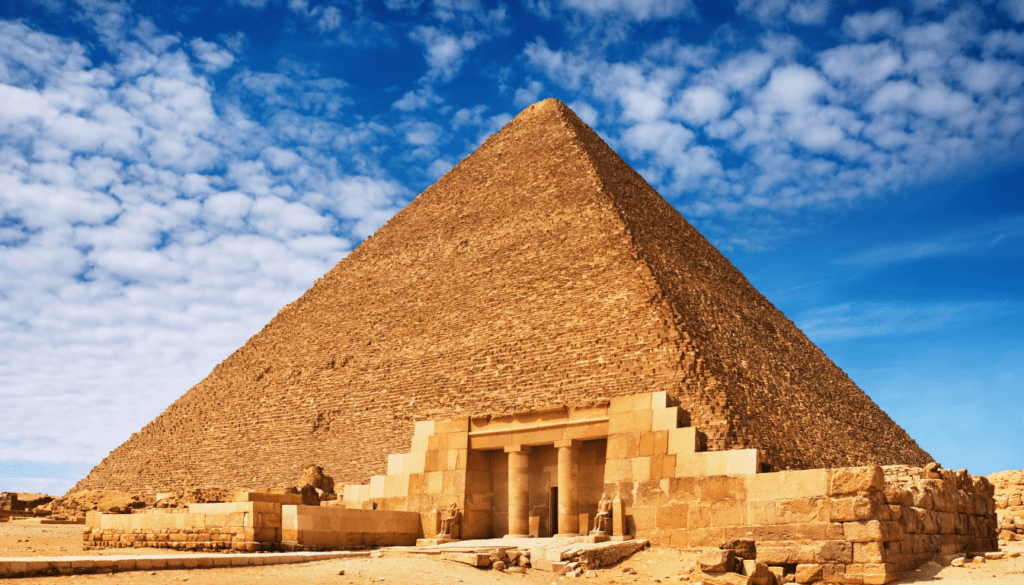
The Pyramids of Giza stand as a must-see in Egypt. The Great Pyramid of Khufu is the most famous. Khufu’s cousin, Hemon, designed it. It was 482 feet (147 m) high, with sides that were 755 feet (230 m).
This pyramid was once shiny because of polished limestone. This shiny look was especially visible in sunlight.
The Great Pyramid has special rooms inside. The King’s Chamber housed a big granite sarcophagus. The Queen’s Chamber featured a unique angular doorway. These show the great skill of the ancient Egyptian builders.
The Pyramid of Khafre and the Pyramid of Menkaure are also at Giza. These, with the Great Pyramid, make Giza an iconic place. It shows the amazing architecture of the ancient Egyptians.
“The Pyramids of Giza are a true testament to the ingenuity and ambition of the ancient Egyptians. Standing in their shadow, one can’t help but be humbled by the sheer scale and complexity of these timeless wonders.”
Known also as the Pyramid of Cheops, it’s the biggest and oldest in Giza. Khufu’s cousin, Hemon, designed it. It stood 482 feet (147 m) high, with 755 feet (230 m) sides at the base.
The Great Pyramid is precisely aligned with the cardinal directions. Its massive size and special inner rooms astound all who visit. The building of this pyramid shows the ancient Egyptians’ engineering and management skills.
The Egyptian Museum in Cairo is packed with ancient Egyptian artifacts. It holds the world’s biggest collection. You can see items from the Predynastic Period to the Greco-Roman era, covering over five thousand years of history. Walking in, I was struck by the vastness and importance of these treasures.
The Narmer Palette is a special piece in the museum. It’s a carved slab showing the first pharaoh, Narmer, uniting Upper and Lower Egypt. The detailed symbols offer a look into Egypt’s early times.
There’s also a remarkable set of statues. These depict the pyramid builders: Khufu, Khafre, and Menkaure. Made from hard stones like granite, they showcase the artistry of ancient Egyptian craftsmen.
| Visitor Information | Cost |
|---|---|
| Photography Fee (Foreigners) | EGP 50 |
| Video Fee (Foreigners) | EGP 300 |
| Photography Fee (Egyptians/Arabs) | EGP 20 |
Guests can take photos for personal use, but not with flash in King Tutankhamen’s Mask Room. Also, there’s a plan for emergencies. It keeps everyone and the art safe from harm.
If you enjoy history, art, or culture, visiting the Egyptian Museum in Cairo is key. Its many treasures and stories of the past offer a real look into Egypt’s ancient life. It truly carries the country’s legacy forward.
“The Egyptian Museum in Cairo is a window into the past, a place where the grandeur and mystery of ancient Egypt come alive.”
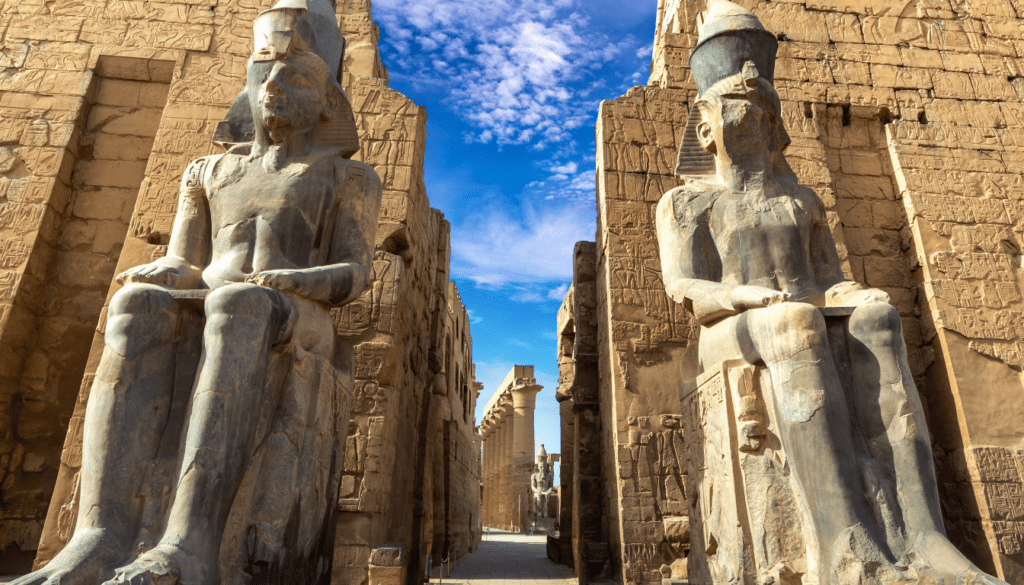
Located by the Nile River, the Luxor Temple shows off ancient Egypt’s glory. It’s devoted to the gods Amun, Mut, and Chons, known as the Theban triad. Here, visitors discover Egypt’s deep history and amazing architecture.
It was built by Amenhotep III and later improved by Tutankhamun and Horemheb. The temple highlights ancient Egyptian building skills and design. The Avenue of Sphinxes, a long path connecting to Karnak Temple, shows its religious importance.
Inside the Great Court, tall columns and detailed carvings are breathtaking. You’ll see statues of famous pharaohs, like Ramses II. They show religious and festival scenes, offering a window into ancient Egypt’s rich culture.
Since 1884, digs have unveiled Luxor Temple’s big role in history. Tourists from all over can now visit this amazing place. They can experience ancient Egypt’s grandness while enjoying the Nile’s beauty.
The Luxor Temple is easy to get to from Luxor town, by rail, or on a cruise. This site is a key stop for anyone keen on Egypt’s wonders. Its well-kept structures and ancient treasures truly reflect ancient Egypt’s splendor.
“Luxor is often referred to as the ‘world’s greatest open-air museum’ for its numerous ancient Egyptian archaeological sites, and the Luxor Temple is a shining example of the region’s architectural and cultural treasures.”
Dedicated to the Goddess Isis
The Temple of Philae is on the island of Agilkia in the Nile River. It shows us the beauty of ancient Egypt and the importance of the goddess Isis. This temple, built between 380-362 BC by King Ptolemy II, mixes Greek-Roman and Egyptian styles perfectly.
The complex has two pylons and a hall with 10 columns. There are also chapels for gods like Osiris and Horus. It was later turned into a Christian church. But, it has stood the test of time. It’s still an icon of ancient Egypt and love for Isis and is a World Heritage Site.
In the 1960s, the building of the Aswan High Dam put the temple in danger. UNESCO led an effort to save it. They moved the whole temple to Agilkia Island. Now, it’s a special place for tourists.
Visitors today see many parts of the Temple of Philae. They can see the Kiosk of Trajan and enjoy the Sound and Light Show. This temple gives us insight into ancient Egypt’s culture.
“The Temple of Philae is a true gem of ancient Egyptian architecture, a testament to the enduring power of the goddess Isis and the resilience of the human spirit.”
If you love history or are fascinated by old civilizations, Philae Temple is a must-visit. It’s a chance to see the past and feel the beauty of this sacred place.
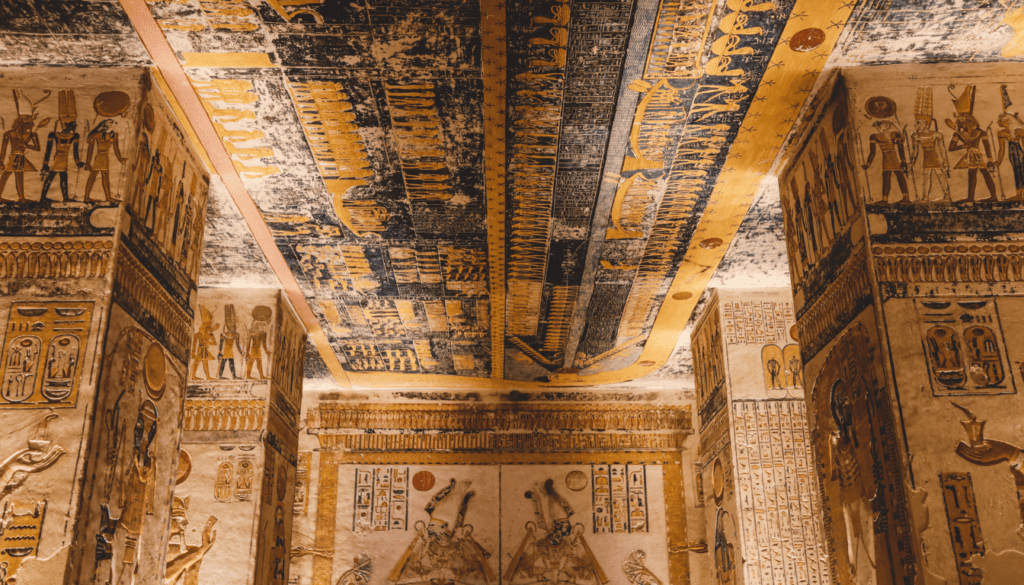
On the other side of the Nile from Luxor is the Valley of the Kings. It’s a place filled with tombs for the pharaohs and noble people of the New Kingdom (1539-1075 BC). Here you’ll find Tutankhamun‘s tomb, fully found in the 1920s. It’s an amazing place that shows us how ancient Egyptians buried their kings and nobles.
The Valley of the Kings was where many kings from different dynasties were laid to rest, from 1539 to 1075 BCE. In this valley, there are 62 tombs. The pharaohs here took a new way to bury their dead. They hid their tombs in a valley behind Dayr al-Baḥrī because they worried about theft.
In Tutankhamun’s tomb (from around 1333–23 BCE), amazing treasures were found in 1922. They give us a great look at what a powerful pharaoh’s burial was like. Queen Hatshepsut‘s tomb is also here. It’s deep in the mountain, nearly 700 feet from the entrance, going down 320 feet.
The biggest tomb in the valley (number 5) was possibly for the sons of Ramses II (from 1279–13 BCE). It was very complex, with many corridors and chambers. In ancient times, Greek travelers could see 40 tombs here.
| Key Facts about the Valley of the Kings |
|---|
| – The Valley of the Kings dates back to 1539 BC and houses a total of 63 tombs, with the oldest belonging to Thutmose I. |
| – It contains 20 tombs dedicated to Egyptian kings, with the other tombs housing queens, children, and other nobles. |
| – King Tutankhamen’s tomb, discovered in 1922, is known for being relatively intact compared to other tombs. |
| – The Valley of the Kings spans approximately 2 kilometers (1.2 miles) and is divided into two branches, the East Valley and the West Valley. |
| – Visitors can explore the valley’s tombs with guidance from expert Egyptologists, or take a hot air balloon ride for a bird’s-eye view of the site and surrounding attractions. |
Tutankhamun’s small tomb managed to stay safe from thieves. It lets visitors see the incredible treasures a pharaoh was buried with. The Valley of the Kings is a place you can’t miss when visiting Egypt. It shows you the ancient Egyptian way of burying their important people.
Must-See Historical and Archit. Spots in Egypt

Egypt is full of historical and architectural wonders that show its rich past. The Pyramids of Giza, Luxor and Aswan temples are just a few to mention. They let us see ancient Egypt’s building skill and unique stories.
The Great Pyramid of Khufu, Khafre, and Menkaure in Giza are huge stone structures. They were built some 4,500 years ago in ancient Egypt’s Old Kingdom. People visit from all over to see these amazing feats of construction.
In Cairo, the Egyptian Museum holds King Tutankhamun’s treasures and other ancient items. Luxor Temple, more than 3,400 years old, saw pharaohs crowned and became a church later.
Go south and see the Philae temples for Isis and the Valley of the Kings. This valley houses the tombs of more than 60 New Kingdom pharaohs. Djoser’s Step Pyramid, near Cairo, was the first smooth-sided pyramid.
At Karnak, see the grand Hypostyle Hall with its huge columns. The Abu Simbel Temples are also a must-visit. They were built by Ramesses II and his queen and moved to avoid flooding.
From the Mosque of Ahmad ibn Tulun to Saqqara and Edfum, Egypt is a treasure trove. Take a Nile River cruise or an Egypt tour to explore. You’ll dive into ancient Egypt’s stories and see its unforgettable structures.
| Monument | Location | Highlights |
|---|---|---|
| Pyramids of Giza | Giza | The largest and most famous pyramids in Egypt, dating back to the 4th Dynasty |
| Egyptian Museum | Cairo | Unparalleled collection of ancient artifacts, including the treasures of King Tutankhamun |
| Luxor Temple | Luxor | A 3,400-year-old temple that served as a coronation site for pharaohs and later became a Christian church |
| Temple of Philae | Aswan | Temples dedicated to the goddess Isis, showcasing the transition from Ancient Egyptian to Christian worship |
| Valley of the Kings | Luxor | Home to over 60 tombs and 120 chambers of ancient pharaohs and noblemen from the New Kingdom era |
| Step Pyramid of Djoser | Saqqara | The oldest pyramid in Egypt, serving as a prototype for later smooth-sided pyramids |
| Karnak Temple Complex | Luxor | One of the world’s largest ancient religious sites, featuring the iconic Hypostyle Hall with 134 massive columns |
| Abu Simbel Temples | Aswan | Massive rock-cut temples dedicated to Ramesses II and Queen Nefertari, relocated to avoid Nile flooding |
Visit these spots in Egypt to glimpse its remarkable past. Whether you’re into history, religion, or just love giant structures, Egypt has it all.
“Egypt is not just a country, it is a living, breathing museum.” – Anita Diament
Embark on a journey through Egypt’s ancient wonders. From Giza’s Pyramids to Luxor’s temples, each place is filled with stories. You’ll be amazed by what ancient Egyptians achieved.
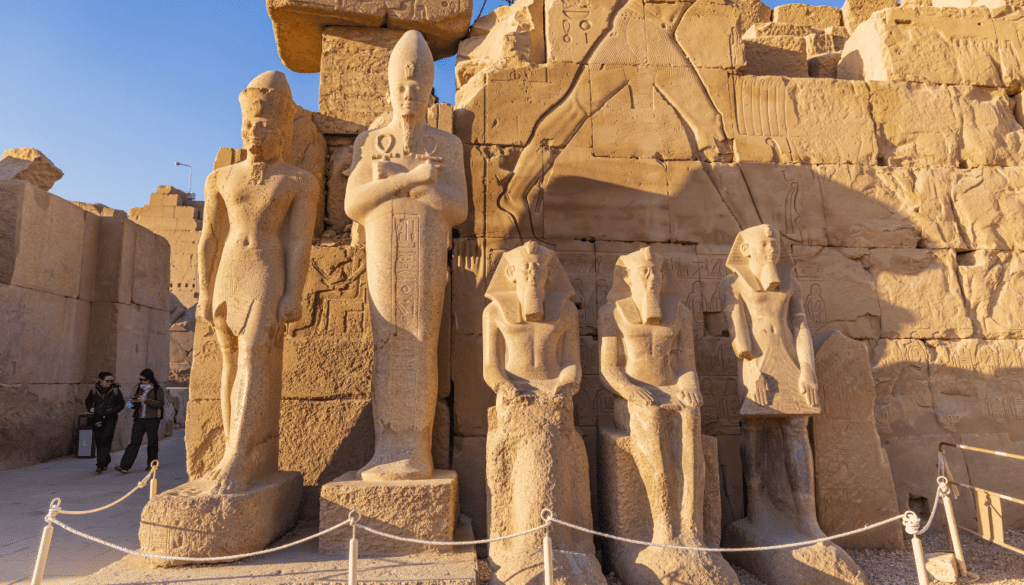
In the heart of Luxor, the grand Karnak Temple Complex showcases Ancient Egypt’s splendor. Covering over 200 acres, it features temples and stunning structures. These have dazzled visitors for ages.
The Great Hypostyle Hall
The Great Hypostyle Hall at Karnak leaves all who see it breathless. It boasts an amazing 134 huge columns, set in a precise grid. This display highlights the amazing skills of Ancient Egyptian architecture. The precision and grandeur stand as a testament to the ancient builders’ genius.
For more than 1,000 years, the UNESCO World Heritage site has been a religious hub. Additions were made from the Middle Kingdom to the early Christian period. It’s a top spot to witness the monumental history of Ancient Egypt.
“Karnak offers an impressive presentation of ancient Egyptian religious practices and beliefs, showcasing gods worshipped from some of the earliest deities to some of the latest.”
The Great Hypostyle Hall at Karnak is a breathtaking example of Ancient Egyptian architecture. Its towering columns and detailed carvings whisk visitors to an ancient world. A walk through this historic space promises an unforgettable experience.
| Fact | Statistic |
|---|---|
| Age of Karnak Temple Complex | 4,000 years old |
| Number of columns in Amun’s temple | Over 130 |
| Length of the Avenue of the Sphinxes | 1.7 miles |
| Number of sphinx statues along the Avenue of the Sphinxes | More than 1,300 |
| Height of the Colonnade of Amenhotep III columns | 52 feet |
| Height of the Luxor Temple Pylon of Ramses II obelisk | 82 feet |
| Size of the Court of Amenhotep III at Luxor Temple | More than half an acre |
| Height of the papyrus columns in the Court of Amenhotep III | 50 feet |
| Area of the Hypostyle Hall at Karnak | Approximately 54,000 square feet |
| Number of columns in the Hypostyle Hall | 134 |
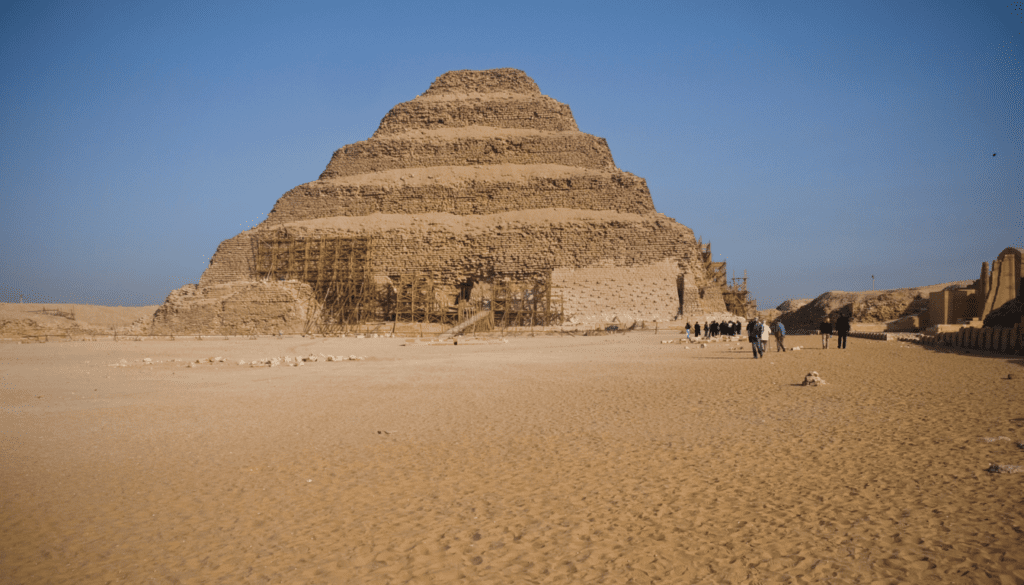
The Step Pyramid of Djoser is in Saqqara, an ancient city. It shows Egypt’s impressive skills in architecture and engineering. Built in the 27th century BC, it’s the oldest known stone building. The famous architect Imhotep designed it during the 3rd Dynasty for Pharaoh Djoser.
This pyramid is a wonder from its time. It has six parts stacked up, reaching nearly 60 meters high. The base is about 105 meters long and wide. These parts are called mastabas, and they are flat and rectangular.
The Step Pyramid isn’t just a big building. It’s like a small model of the cosmos, showing the afterlife, earth, and heavens. Inside, there is a labyrinth of tunnels and rooms. The main shaft, 28 meters deep, is central to this design.
To the east, there’s a temple where rituals were performed for the dead pharaoh. This temple is an outstanding piece of ancient engineering. In fact, the whole area of Saqqara is part of a UNESCO World Heritage Site since 1979. It’s a key reminder of Egypt’s rich history and culture.
In March 2020, the pyramid opened for inside visits. A 14-year, $6.6 million restoration project made this possible. Now, guests can see and feel the history of ancient Egypt in a new way.
| Fact | Value |
|---|---|
| Location | Saqqara, Egypt |
| Construction Period | 27th century BC |
| Architect | Imhotep |
| Height | Approximately 63 meters |
| Base Dimensions | 121 meters by 109 meters |
| Restoration Cost | $6.6 million |
| Restoration Duration | 14 years |
The Step Pyramid of Djoser is proof of ancient Egypt’s cleverness. It stands out in Saqqara, attracting people worldwide. This marvelous structure highlights the great legacy of ancient Egypt.
“The Step Pyramid of Djoser is not just a monument, but a testament to the genius and vision of the ancient Egyptians. Its design and construction are a true marvel of engineering and architectural prowess.”
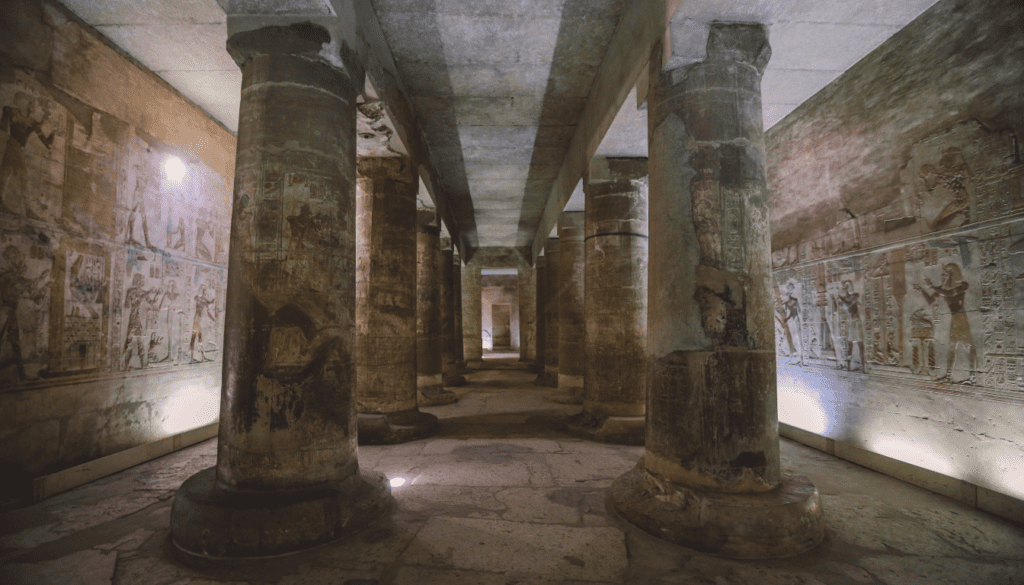
In the heart of Middle Egypt lies the Abydos Temple. It shows us the amazing legacy of ancient Egyptian culture. This historical gem sits about 50 km north of Sohag. It welcomes you to explore Egypt’s ancient past.
The Abydos Temple area has been a home for over 5,000 years. Many pharaohs, like Pepi I and Sesostris III, improved the site. The temple grew big and beautiful through the work of several pharaohs.
One big draw is the Abydos King List, a list of Pharaohs from Menes to Ramses I. It’s a special look into the history of Egyptian leaders. You won’t find this anywhere else.
Seti I of Dynasty XIX made the temple as it looks today. It has a unique L-shape and seven rooms for Egypt’s main gods. The carvings on the walls show the amazing work of Egyptian artists.
The Osireion is another must-see. Seti I built it. It’s a place with a story to tell about creation and the god Osiris.
For anyone who loves history, the Abydos Temple is a dream. It shows the power and beauty of Pharaonic Egypt. Don’t miss the Abydos King List or the stunning art at this site. It’s a top spot for exploring ancient Egypt.
“The Abydos Temple stands as a testament to the enduring legacy of ancient Egyptian civilization, inviting visitors to explore the grandeur and mystery of the Pharaonic past.”
The Abydos Temple is a top choice, whether you’re exploring for the first time or are a seasoned traveler. It takes you back to Egypt’s golden time with its rich history and unique architecture. This site is a highlight for anyone who loves culture and the wonders of Egypt.
| Key Facts about Abydos Temple | Details |
|---|---|
| Location | Abydos is located in the low desert west of the Nile River near Al-Balyanā in Egypt. |
| Time Period | The tombs at Abydos date back to the 1st and 2nd dynasties of ancient Egypt, with excavations revealing even earlier tombs predating the 1st dynasty. |
| Predynastic Kings | Tombs at Abydos have yielded intact pottery, royal emblems, and the names of several predynastic kings. |
| Periods of Dynasties | The kings of the 1st dynasty reigned around 2925–2775 BCE, while the 2nd dynasty ruled from about 2775–2650 BCE. |
| Cult of Osiris | In the 5th dynasty, around 2465–2325 BCE, the cult of Osiris absorbed that of the jackal god, Khenti-Imentiu, at Abydos, making it the focal point of Osiris worship. |
| Temples | Pharaohs such as Pepi I, Ahmose I, Thutmose III, Ramses III, and Ahmose II successively rebuilt or enlarged the temple of Osiris at Abydos over the centuries. |
| Temple of Seti I | Seti I’s temple at Abydos features seven sanctuaries, two hypostyle halls, and a gallery with a relief known as the Abydos list of kings. |
| Osireion | Seti’s cenotaph at Abydos is an underground vaulted hall with a central platform and 10 monolithic pillars surrounded by water. |
| Cemeteries | A vast complex of cemeteries surrounds the temples at Abydos, used from prehistoric times to Roman periods. |
The Abydos Temple is an incredible site that keeps the magic of ancient Egypt alive. Whether you’re drawn to the Abydos King List, the Osireion, or the detailed reliefs, you’ll have an amazing time. It’s a place that truly brings Egypt’s ancient wonders to life.
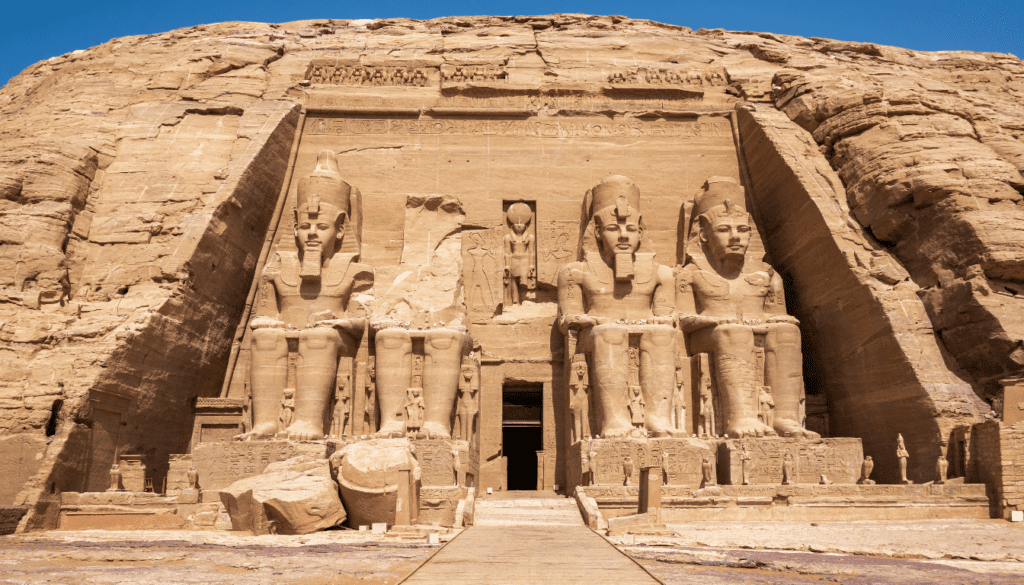
Located on the west bank of the Nile River, the Abu Simbel Temples are about 230 kilometers from Aswan. Constructed by pharaoh Ramses II, they are a symbol of ancient Egypt’s greatness.
The first temple, dedicated to Ramses II and gods, is a grand sight. It has a big front with four statues of Ramses II. Inside, you’ll find a hall with pillars that take your breath away.
The temples’ real wonder is how they line up with the sun twice a year. On October 22 and February 22, sunlight shines into the sanctuary. This “Abu Simbel Sun Alignment” shows the Egyptians’ deep knowledge of stars.
The smaller temple is for the goddess Hathor and Queen Nefertari. It has Ramses II’s and Nefertari’s statues on the front. It’s definitely worth seeing.
In the 1960s, the Abu Simbel Temples faced flood risks due to a dam project. However, the UNESCO led a huge effort to move them to higher ground. This move protected the temples for the future.
Visitors today can see the Abu Simbel Temples, thanks to ancient and modern engineering. The site amazes with its size, beauty, and historical value.
“The Abu Simbel temples are among the most magnificent monuments in the world, a testament to the enduring legacy of ancient Egyptian civilization.” – UNESCO
Whether you love history, architecture, or ancient wonders, the Abu Simbel Temples are a must-see in Egypt. They let you step back in time to the era of pharaohs and gods.
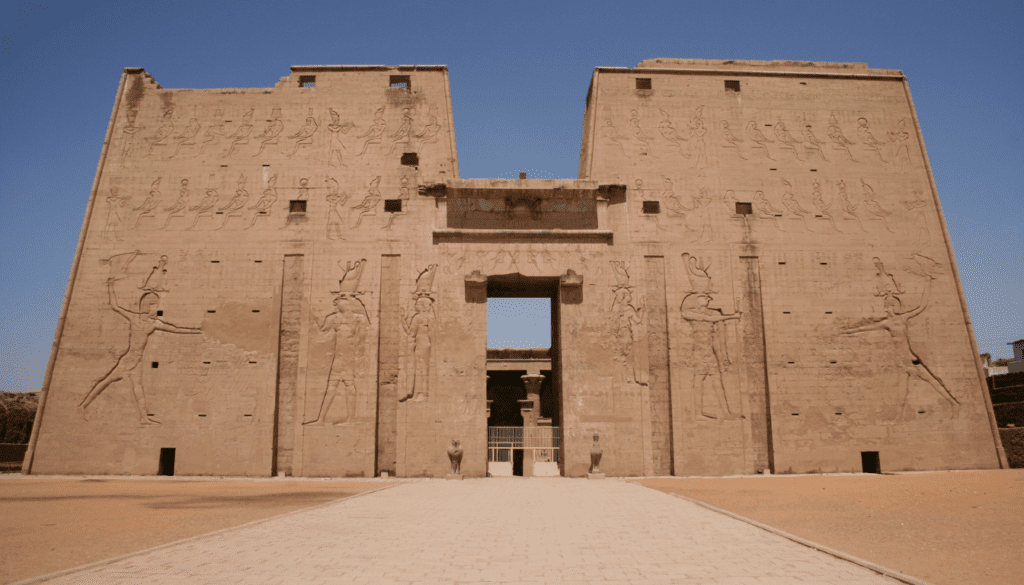
The Temple of Edfu is found on the west bank of the Nile River. It’s a stunning example of architecture and religious dedication from ancient Egypt’s Ptolemaic time. This temple, for the falcon god Horus, is seen as one of Egypt’s best-preserved.
It was built over 180 years, from 237 BC to 57 BC, by many Ptolemaic kings. The main part was finished in 25 years by Ptolemy III. Then, Ptolemy IV spent six years adding all the decorations.
This temple has a mix of ancient Egyptian and Greco-Roman styles. You’ll see massive walls and a grand courtyard with a hall of 18 columns. It’s truly amazing to be there.
The “Mamisi,” a birth chamber, is another unique part. It’s 36 meters high and has Horus statues. That place tells the story of Horus’s birth and how he won over Set.
It’s not just about big buildings at the Temple of Edfu. There are also many old drawings and scriptures. These show what life and beliefs were like during the Ptolemaic time.
The Temple of Edfu is a top pick for history lovers and those who admire ancient architecture. It highlights the great achievements of the Ptolemaic dynasty and ancient Egyptians.
“The Temple of Edfu is a masterpiece of Ptolemaic architecture, blending the grandeur of ancient Egyptian design with the elegance of Greco-Roman influence. Its intricate inscriptions and stunning visual elements make it a true jewel in the crown of Egypt’s historical sites.”
If you love history, architecture, or Egypt’s ancient world, you must visit the Temple of Edfu. It will truly impress you.
Mosque of Aḥmad ibn Ṭūlūn
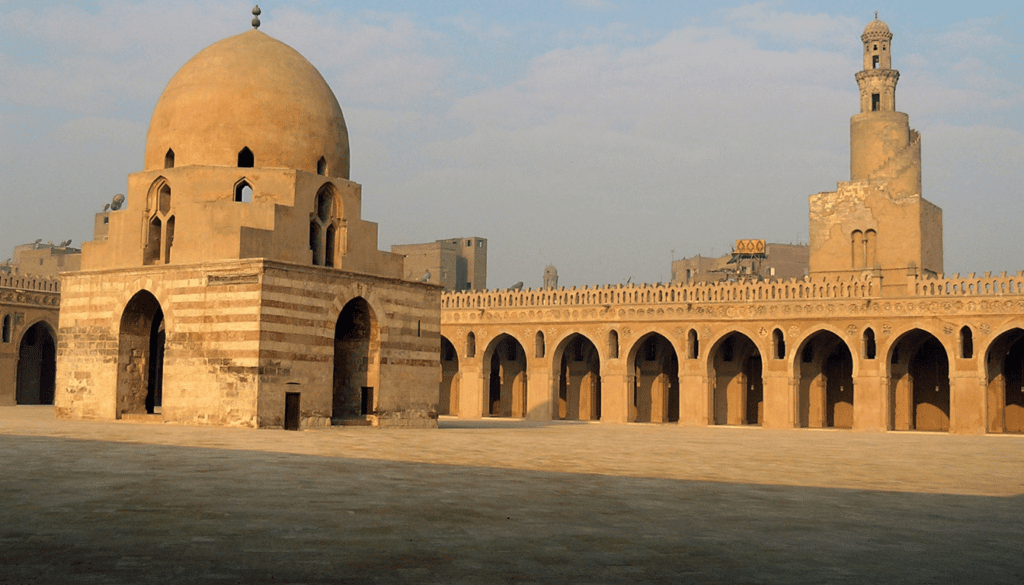
In the heart of Cairo stands the Mosque of Aḥmad ibn Ṭūlūn. It showcases the grand design of the Islamic era beautifully. Aḥmad ibn Ṭūlūn, an Abbasid governor, built this structure in the 9th century. It is a key example of the Ṭūlūnid Dynasty’s architectural work that still stands.Worth noting is the helix-shaped minaret with a spiraling external staircase and other unique features. These show a mix of Mesopotamian and Egyptian styles. The mosque was opened in 884 AD and covers over 26,000 square meters. This makes it Egypt’s oldest and one of the largest mosques.
The mosque draws from the architecture of the Abbasid caliphs, based in Samarra, Iraq. Aḥmad ibn Ṭūlūn, who broke free from the Abbasid rule to found the Ṭūlūnid Dynasty, played a big role. His independence move in 868 AD began a period of unique architecture in Cairo.
This mosque has seen many makeovers, with the latest in 2004. These renovations have kept its classic Islamic look alive. Visitors today get a taste of Egypt’s cultural richness from the Ṭūlūnid era.
“The Mosque of Aḥmad ibn Ṭūlūn is a true masterpiece of classical Islamic architecture, showcasing the unique blend of Mesopotamian and Egyptian styles that defined the Ṭūlūnid Dynasty’s architectural legacy.”
If history or architecture excites you, visit the Mosque of Aḥmad ibn Ṭūlūn in Cairo. Dive into the majesty of this landmark and explore its fascinating tale.
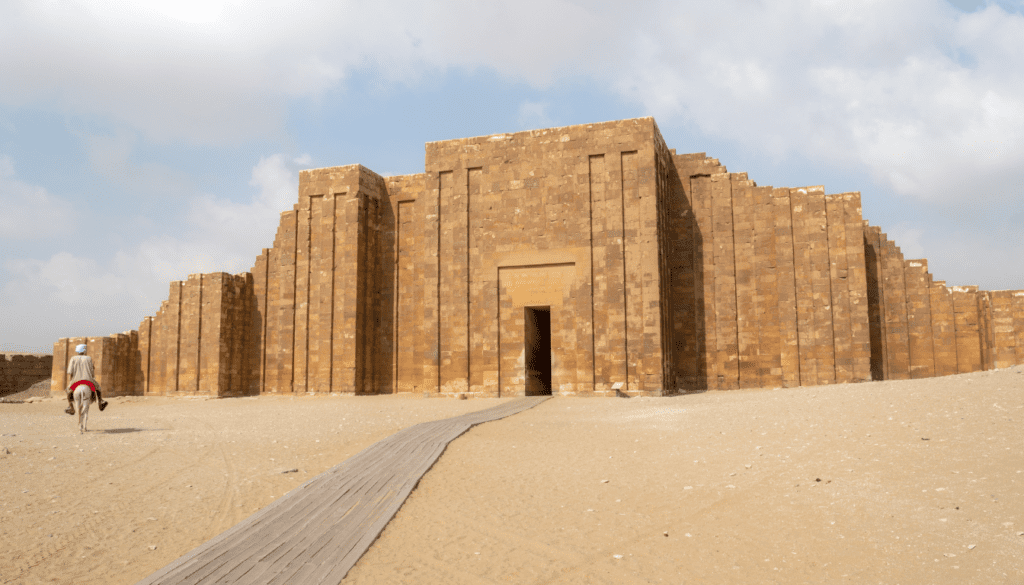
Just 30 kilometers south of Cairo, you’ll find the Saqqara Necropolis. It stands as proof of the ancient Egyptians’ architectural brilliance. This complex is filled with pyramids, tombs, and monuments. It shows how tomb design changed over 5,000 years of Egyptian history.
The area’s highlight is the Step Pyramid of Djoser. It’s the oldest large stone building. Built around the 27th century BC, it’s the first true pyramid. It laid the foundation for the famous pyramids at Giza.
Saqqara was a favorite place for important people to be buried during certain periods of Egyptian history. That’s why many tombs of high officials and generals have been found there. Excavations in the ’80s and early ’00s revealed these tombs. They give insight into the lives of the elite of ancient Egypt.
One of Saqqara’s wonders is its early stone columns. The columns at Zoser’s precinct are thought to be the first of their kind. They show a mix of building traditions from Upper and Lower Egypt. This reflects the unity of ancient Egypt.
Imhotep, the architect, is known for turning temporary construction into lasting stone buildings. He is the first known artist in history. His work strengthened the idea of a united Egyptian kingdom. He made an important mark on Egyptian culture and architecture.
Today, the Saqqara Necropolis still draws people with its history and beauty. The Step Pyramid of Djoser and the decorated tombs of the officials are must-sees. This site offers a detailed look at ancient Egyptian tomb building and the skills of its craftsmen.
Conclusion
Thinking back on my trip exploring Egypt’s historic places and amazing buildings, I’m amazed. The towering pyramids at Giza and the intriguing sights at the Grand Egyptian Museum took me on a journey back in time. I got to see where early civilizations began. It’s awe-inspiring to witness the culture and legacy of ancient Egypt.
I was really impressed by the ancient Egyptians’ cleverness and the way they built massive structures. Places like the Valley of the Kings and the Karnak Temple Complex showed me their incredible craftsmanship. These buildings still amaze and inspire people today.
As I get ready to leave Egypt, I feel deeply thankful for the country’s enduring charm. Its mix of modern cities and serene Nile River landscapes is stunning. Egypt brilliantly blends its ancient past with its new influences. And I’m eager to come back and find more of Egypt’s wonders. This journey has been unforgettable, letting me explore one of the world’s oldest and most interesting places.
FAQ
What are the must-see historical and architectural spots in Egypt?
Egypt is full of incredible sights. Some of the most famous include the Pyramids of Giza. You’ll also love the Egyptian Museum in Cairo. Then there’s the Luxor Temple and the Temple of Philae. Not to mention the Valley of the Kings with its many tombs. The Karnak Temple and the Step Pyramid are also must-visits.
What is the Great Pyramid of Khufu?
The Great Pyramid of Khufu is the biggest of the three Pyramids of Giza. It was built about 4,500 years ago. This pyramid stands at 482 feet high, with bases measuring 755 feet. This ancient wonder of the world was built by Pharaoh Khufu’s workers.
What can I find at the Egyptian Museum in Cairo?
The Egyptian Museum has a huge collection, including items from the time of the dinosaurs. You will find Pharaoh artifacts, mummies, and more. There are treasures like the ones from Tanis and the Narmer Palette. You’ll also see statues of the great pyramid builders.
What is the Luxor Temple known for?
The Luxor Temple in Egypt is over 3,000 years old. It is on the east side of the Nile River. This temple was built for the gods Amun, Mut, and Khonsu. It’s a big example of the wonders of ancient Egypt.
What is the significance of the Temple of Philae?
The Temple of Philae is special because it was moved to save it. It was in danger of being underwater. Now, on Agilkia Island, it looks amazing. You can see its story told in a light and sound show.
What can be found in the Valley of the Kings?
The Valley of the Kings is on the west bank of the Nile. It has many tombs and temples. These places were made for pharaohs over 3,000 years ago. One tomb there, of Tutankhamun, is very famous.
What is the Karnak Temple Complex known for?
The Karnak Temple is a huge complex. It covers over 200 acres. Its most stunning part is the Great Hypostyle Hall. Here, you can see 134 giant columns. Visitors can feel the power of ancient Egypt there.
What is the significance of the Step Pyramid of Djoser?
The Step Pyramid is the world’s oldest stone building. Only one of its kind, it started the pyramid trend. This place shows Egypt’s early use of columns and its creativity.
What can be found at the Abydos Temple?
The Temple of Seti I has Egypt’s old King List and many stories. Its walls are filled with art. This is a great place for people who love history.
What are the twin temples of Abu Simbel?
The two Abu Simbel temples are major works of Ramses II. They were moved to save them from water. They shine in the sun twice a year. This event brings many visitors.
What is the significance of the Temple of Edfu?
The Temple of Edfu, for the god Horus, is in great shape. It shows the passion and skills of the people in charge back then. This period was marked by strong beliefs and grand architecture.
What is the Mosque of Aḥmad ibn Ṭūlūn known for?
The Mosque of Aḥmad ibn Ṭūlūn is from the classical Islamic times. It shows a mix of Mesopotamian and Egyptian styles. This unique place tells an interesting story of that era.
What can be found at the Saqqara Necropolis?
Saqqara has many pyramids, including the famous Step Pyramid. It shows how tombs changed over time in Egypt. This site is crucial for learning about Egypt’s long history.





















